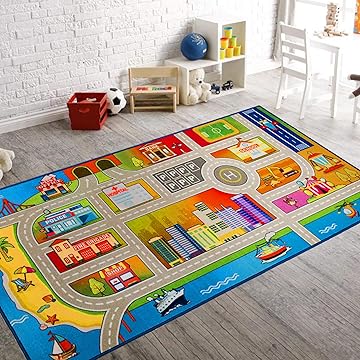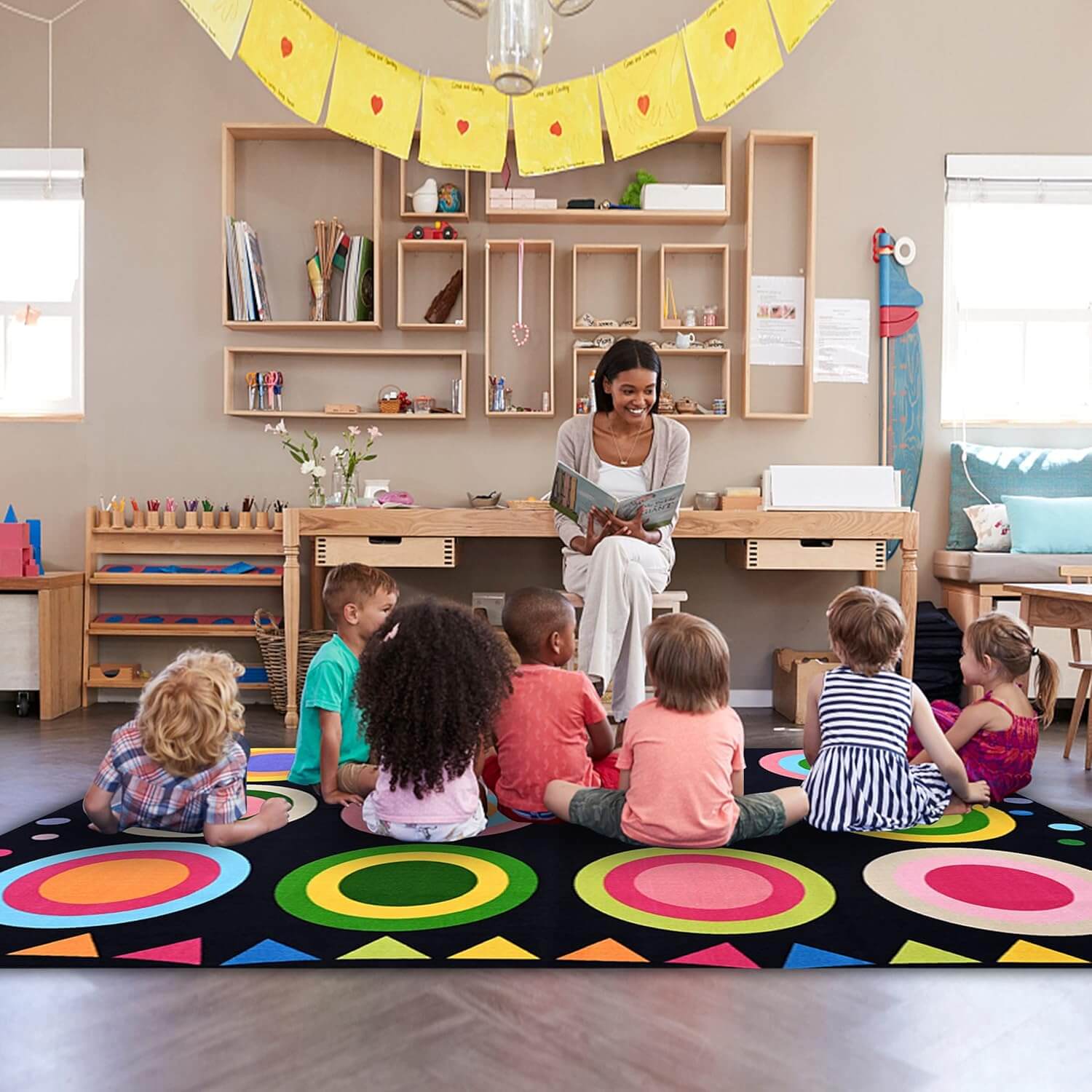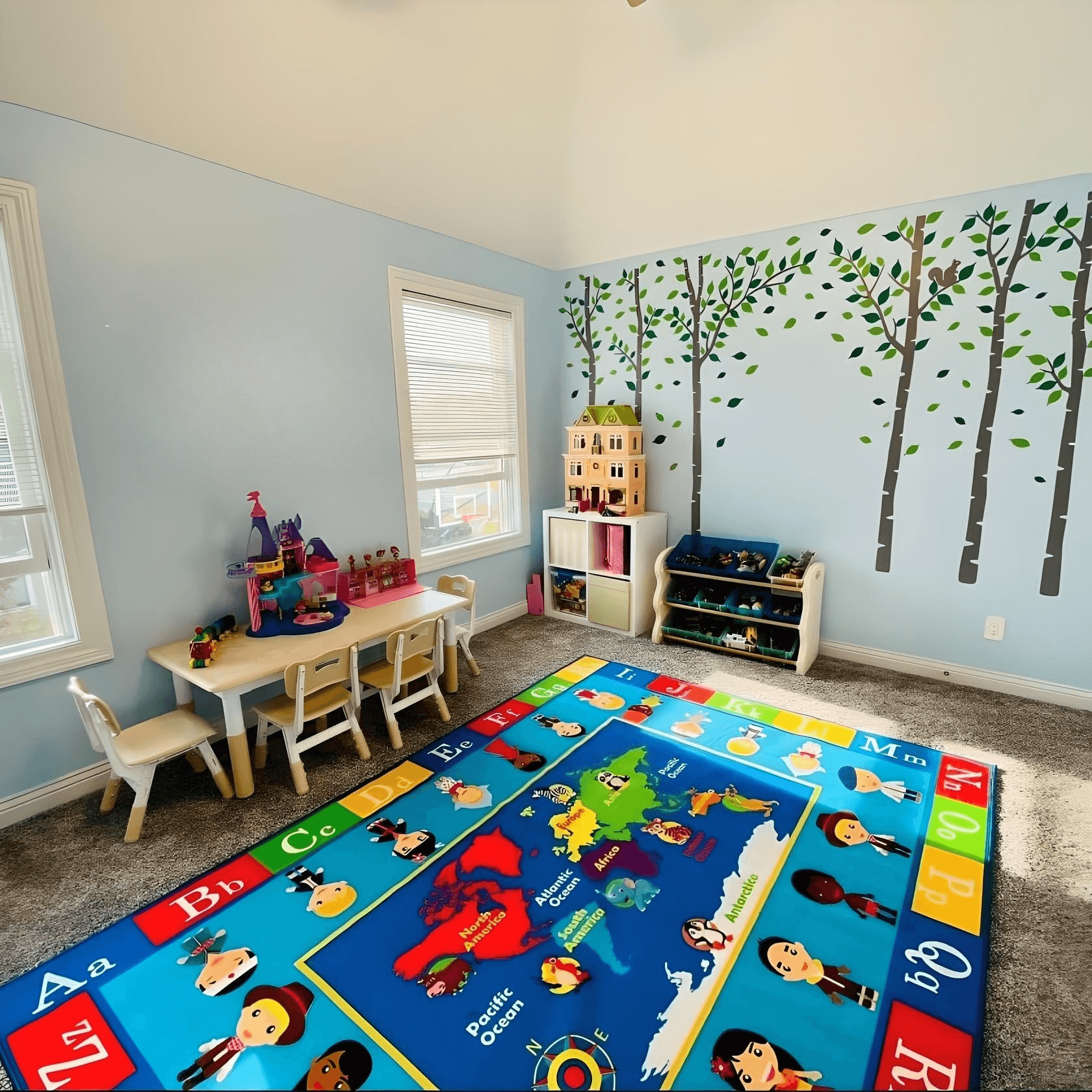The environments where young children learn and grow significantly impact their development across multiple domains.
While much attention focuses on educational materials, teacher interactions, and curriculum design, emerging research highlights the importance of environmental elements—including specialized classroom rugs—in supporting optimal early childhood development.
This comprehensive examination of current research explores how carpeting in early learning environments influences physical, cognitive, social-emotional, and language development in children from birth through age eight.
Physical Development Benefits: Supporting Motor Skill Development
Research consistently demonstrates that soft, stable flooring surfaces like carpet provide ideal conditions for developing foundational motor skills in young children.
Gross Motor Development
Studies examining gross motor development highlight several benefits of carpeted surfaces:
- Balance acquisition: Research from the Journal of Motor Learning and Development indicates that slightly yielding surfaces like low-pile carpet provide optimal stability challenges for developing balance, creating micro-adjustments that strengthen core muscles without excessive falling risk.
- Crawling progression: Longitudinal studies show infants typically progress through crawling stages more effectively on spacious large classroom rugs, which provide necessary traction without skin abrasion, which provide necessary traction without skin abrasion.
- Confidence in movement: Observational research indicates young children attempt complex movements more willingly on carpeted surfaces, where fear of falling is reduced.
Fine Motor Benefits
Beyond gross motor development, research shows carpet environments support fine motor skill development:
- Floor-based manipulation: Young children engage more extensively with small manipulatives when seated on comfortable carpet versus hard surfaces.
- Proprioceptive feedback: The slight cushioning of carpet provides enhanced proprioceptive input during fine motor activities, supporting better body awareness.
- Extended floor play: Studies measuring engagement duration show significantly longer periods of floor-based fine motor play on carpeted versus hard surfaces.
Cognitive Development Impact: Creating Thinking Spaces
Research examining learning environments demonstrates that floor surfaces influence cognitive engagement and learning outcomes in surprising ways.
Attention and Focus
Multiple studies highlight carpet's role in supporting sustained attention:
- Noise reduction impact: Research measuring classroom noise levels shows carpeted classrooms have background noise reductions of 35-50%, significantly increasing measurable attention spans during instruction.
- Defined thinking spaces: Studies of classroom design show carpet areas designated for specific cognitive activities develop stronger cognitive associations for those activities.
- Comfort correlation: Research from educational environment studies demonstrates physical comfort directly correlates with improved cognitive task performance in early childhood.
Spatial Reasoning Development
Carpet-based activities show particular benefits for spatial development:
- Grid-based understanding: Research using grid patterns on colorful classroom rugs shows enhanced development of early mathematic spatial concepts versus unmarked surfaces.
- Mental mapping: Studies of preschool environments indicate children develop stronger mental maps of spaces with varied flooring textures, with carpet areas being most consistently remembered.
- Defined learning zones: Research examining zoned classrooms shows carpet-defined areas create cognitive boundaries that help young children categorize learning experiences.
Social-Emotional Benefits: Community Building through Comfort
The psychological comfort provided by carpet appears to significantly impact social-emotional development in early childhood environments.
Emotional Regulation Support
Research indicates carpeted spaces support emotional regulation development:
- Comfort seeking: Observational studies show children overwhelmingly select carpeted areas for self-soothing and emotional regulation during distress.
- Restorative spaces: Research measuring cortisol levels shows lower stress indicators in soft, home-like environments created by boho classroom rugs versus hard surface areas.
- Group regulation: Studies of preschool gathering activities demonstrate more effective co-regulation during challenging tasks when conducted on comfortable carpeted surfaces.
Social Interaction Facilitation
Carpeted areas appear particularly conducive to positive social development:
- Gathering behavior: Sociometric research shows preschoolers spontaneously gather for social interaction on designated classroom seating rugs at nearly three times the rate of hard surface areas.
- Collaboration quality: Studies measuring collaborative task outcomes show higher quality collaborative products when young children work together on carpeted versus hard surface areas.
- Conflict resolution: Observational research indicates conflicts between young children resolve more effectively in comfortable carpet spaces than in hard surface areas.
Sensory Processing Considerations: Meeting Diverse Needs
Research examining children with various sensory processing patterns highlights carpet's important role in creating inclusive environments.
Sensory Seeking Support
For children with sensory seeking patterns, research demonstrates:
- Proprioceptive input: Studies measuring sensory integration show carpet provides beneficial proprioceptive feedback for sensory-seeking children during movement activities.
- Controlled tactile stimulation: Research examining tactile processing indicates carpet offers beneficial consistent tactile input without overwhelming sensory systems.
- Vestibular development: Research shows the slight instability of carpet provides beneficial vestibular challenges without triggering fear responses in sensory-seeking children.
Sensory Sensitive Accommodations
For children with sensory sensitivities, research highlights:
- Acoustic benefits: Studies measuring sensory responses show carpeted environments significantly reduce auditory distress for children with auditory sensitivities.
- Visual calming: Research demonstrates that solid-colored or pastel classroom rugs reduce visual system stress for children with visual processing sensitivities.
- Transition support: Studies of environmental transitions indicate carpeted areas provide crucial sensory buffers for children with transition sensitivities.
Language Development Connection: Communication-Enhancing Environments
Emerging research highlights surprising connections between carpeted learning environments and language development outcomes.
Acoustic Clarity Benefits
Research examining language acquisition environments emphasizes:
- Speech signal clarity: Acoustic studies show carpeted preschool environments improve speech discrimination by reducing reverberation, resulting in better phonological development.
- Background noise reduction: Research measuring teacher speech intelligibility demonstrates significantly higher comprehension scores for young children in carpeted versus hard-surface classrooms.
- Instructional effectiveness: Studies examining early literacy instruction show higher skill acquisition in carpeted learning areas versus identical instruction in hard-floored spaces.
Conversation Facilitation
Research on communication development shows:
- Conversation duration: Observational studies indicate peer conversations last significantly longer when occurring on comfortable carpeted areas versus hard surfaces.
- Turn-taking development: Research examining communication skills shows more effective turn-taking development during activities conducted on defined carpet areas.
- Early literacy engagement: Studies show significantly longer engagement with books when reading areas feature comfortable reading rugs.
Safety and Health Research: Evidence-Based Design Decisions
Comprehensive research on early childhood environments addresses both safety benefits and health considerations of carpet in learning spaces.
Injury Prevention Findings
Safety research demonstrates important protective benefits:
- Fall impact reduction: Biomechanical testing shows properly installed commercial carpet with appropriate padding reduces head injury criteria (HIC) measurements by 35-70% compared to hard surfaces.
- Surface-related injury data: Pediatric injury surveillance data indicates significantly lower rates of serious injuries from falls in carpeted versus non-carpeted early childhood environments.
- Slip reduction: Gait analysis research shows properly maintained commercial carpet substantially reduces slip-and-fall incidents in early childhood settings.
Health Consideration Research
Health-focused research provides important context:
- Allergen management: Current research from pediatric environmental health studies indicates properly maintained commercial carpet can actually trap allergens that would otherwise remain airborne, improving indoor air quality when regularly cleaned.
- Microbiological considerations: Research comparing microbial populations shows properly maintained commercial carpet harbors fewer human pathogens than many hard surfaces due to competitive microbial colonization.
- Cleaning effectiveness: Studies measuring contaminant removal show properly implemented hot-water extraction cleaning effectively removes potential health hazards from commercial carpet.
Research-Backed Implementation: Translating Evidence to Practice
Educational environment research provides clear guidelines for implementing carpet to maximize developmental benefits while addressing practical concerns.
Research-Based Selection Criteria
Studies examining carpet performance in educational settings recommend:
- Pile height considerations: Research indicates low-pile (less than ⅜") commercial carpet optimizes developmental benefits while minimizing maintenance challenges.
- Density importance: Studies correlating carpet specifications with performance show high-density construction (minimum 5,000 oz per cubic yard) provides necessary durability for educational settings.
- Backing systems: Research on moisture management indicates carpet with impermeable backing systems prevents subfloor biological growth while maintaining cushioning benefits.
Maintenance Protocol Research
Studies examining health outcomes in carpeted environments establish:
- Vacuum frequency requirements: Research measuring particulate removal shows daily vacuuming with HEPA-filtered commercial vacuums optimizes air quality in carpeted early childhood environments.
- Extraction cleaning schedules: Studies measuring biological contaminant levels establish quarterly hot-water extraction cleaning as the minimum for maintaining healthy carpet in early learning environments.
- Spot treatment protocols: Research comparing cleaning approaches demonstrates immediate attention to spills using appropriate low-residue cleaners prevents biological growth while maintaining carpet appearance.
Conclusion
The research evidence presents a compelling case for thoughtfully selected and properly maintained carpet as a developmental asset in early childhood environments.
From supporting physical development and enhancing cognitive engagement to facilitating social interaction and improving language acquisition, carpet's multifaceted benefits align with core developmental needs of young children.
While practical considerations regarding selection, installation, and maintenance must be addressed, current research clearly demonstrates that carpet—when properly specified and maintained—contributes significantly to optimal early childhood development across multiple domains.
As early childhood programs increasingly emphasize evidence-based environmental design, carpet emerges not merely as a comfort feature but as an important developmental tool supporting young children's growth and learning.




Leave a comment
This site is protected by hCaptcha and the hCaptcha Privacy Policy and Terms of Service apply.